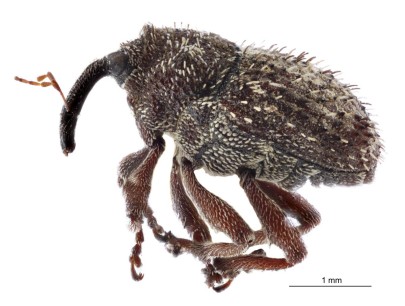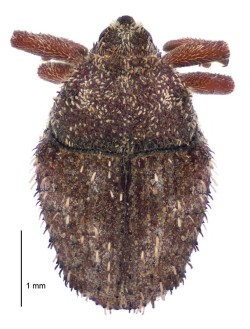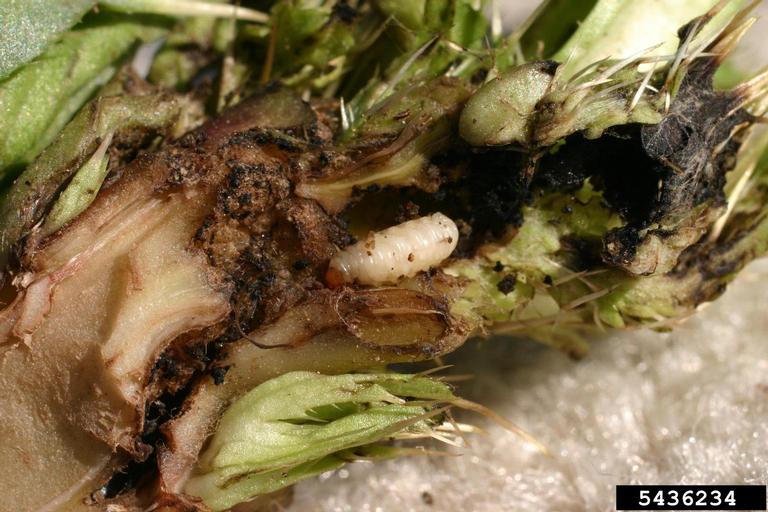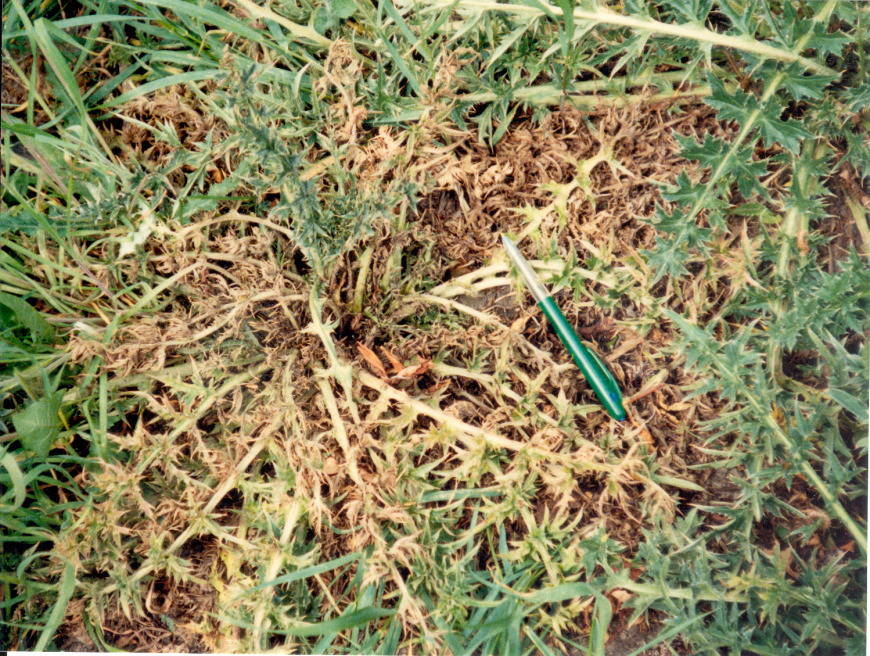Nodding thistle crown weevil
History in New Zealand
Nodding thistle crown weevils are native to Europe, but they were imported by the DSIR in 1982 from Canada, where they have been established as a biocontrol agent. The weevil was mass reared and released widely during the late 1980s and early 1990s. The weevil has established and is becoming widespread in both the North and South Islands.
There has been some uncertainly about whether we have multiple species of crown weevil in New Zealand. All evidence confirms that the only species we have here is Trichosirocalus horridus.
How would I find/recognise it and what is its lifecycle?
You may be able to find the small (3–4 mm long) greyish-brown adult weevils all year round. During the summer, if you look carefully, you may find them in the leaf axils (the junctions between the main stem and lateral stems), growing tips, and flower buds. The adults often hide away (aestivate) during hot dry weather in late summer and may be difficult to find at this time. This behaviour helps crown weevils to survive drought conditions. At other times of the year you may find the adults on or under the rosettes (the round flat growth stage) – you may find adults at times are difficult to distinguish from small crumbs of soil, as they tend to play dead when disturbed.

Image: nodding thistle crown weevil (Trichosirocalus horridus).

Image: nodding thistle crown weevil (Trichosirocalus horridus).
Image: nodding thistle crown weevil hiding in soil.
As a general rule, female weevils lay their eggs from March to November, but some will lay eggs all year round. You will not usually see the eggs as they are laid in protective cavities (with up to four eggs per cavity) along the leaf ribs, but occasionally the yellowish-white eggs are laid on the leaf surface. On average, each female lays 200–300 eggs in her lifetime.
The eggs can take from a week to a month to hatch, depending on the ambient temperature. After hatching, the white grubs crawl down into the centre of the rosette (crown). As the grubs feed in the crown, they produce a black tar-like substance called frass, and the ribs of the surrounding leaves take on a reddish-brown colour at the base. You may see rosettes that look like this in early winter, but the damage usually becomes more obvious later in the winter, and in early spring. It usually takes several years after the weevils have been released at a sit before you can easily find damaged rosettes. You can dig a damaged rosette out of the ground, and cut it in half with a pocket knife to reveal the white grubs inside. The grubs feed in the crown and develop through three growth stages before pupating in the surrounding soil. New adults emerge from the soil after 2–3 weeks, and you can recognise them by their dark brown colour – they fade to a paler shade after a couple of weeks.
Image: nodding thistle crown weevil larvae.

Image: nodding thistle crown weevil larva. Photo credit: Eric Coombs, Oregon Department of Agriculture, Bugwood.org CC BY 3.0.
Image: nodding thistle crown weevil black frass produced by the larvae.
Crown weevils are easy to differentiate from other thistle biocontrol agents.
See Nodding thistle gall fly, Nodding thistle receptacle weevil.
How does it damage nodding thistles?
The adults feed on the green parts of the thistles, but this damage is insignificant. The main damage is caused by the grubs feeding in the crowns which usually kills the plants. Plants that are not killed are stunted, and the grubs will make a further attack on lateral regrowth. Plants of all sizes from seedlings to large rosettes are attacked.

Image: nodding thistle crown weevil damage.
Will it attack other plants?
Although the crown weevil prefers nodding thistle (Carduus nutans), they will also attack other thistles especially plumeless (Carduus acanthoides), winged (Carduus tenuiflorus), slender-winged (Carduus pynocephalus), Scotch (Cirsium vulgare) and cotton (Onopordum acanthium) thistles, and also marsh thistle (Cirsium palustre) to a lesser extent. Other plants are not thought to be at risk.
How effective is it?
If a nodding thistle is severely infested with crown weevil grubs, the crown (centre) is destroyed, and the plant dies. If the infestation is less severe, the thistle may survive, but the new growth will be lighter in colour, less prickly than normal (a bit like dandelion leaves), and fewer, shorter flowering stems will be produced.
At many sites, thistle populations appear to have declined about 5 years after the weevils were released, but their effectiveness has been variable.
How can I get the most out of it?
Although adults can fly, the weevil can take a long time to invade new areas. Studies have shown that the weevils move about 1 km per year. You can accelerate dispersal by collecting crown weevils from well-established sites and moving them to new areas. The best time to do this is either early summer or autumn.
How do I select a release site?
Read Guidelines for selecting release sites for biocontrol agents.
Rosettes, of any size, must be numerous at the site in late summer/early autumn.
How do I collect it for release at other sites?
Read Guidelines for collecting, relocating, and releasing insect biocontrol agents.
You can easily collect crown weevils using a garden-leaf vacuum machine. These machines comprise a petrol motor attached to a long tube for sucking up leaves, and you can purchase one from a garden equipment supplier or borrow one from an equipment hire firm. You could also use an ordinary vacuum cleaner if you have access to a portable generator.
Modify the tube of the garden-leaf vacuum so that the weevils are collected and not sucked through. Take a sleeve of coarsely woven material, with one end sewn shut and the other end open (old socks or pantyhose could be used) and fit it securely around the end so that it forms a bag in the mouth of the tube.
You will find it easier to vacuum rosette plants than large flowering plants, because you can form a better seal with the ground. You will probably find it most productive to vacuum small heavily damaged rosettes.
Every 10 minutes or so, take the sleeve off the end and tip the contents into a holding container. We recommend you shift at least 300 crown weevils in the summer or 200 in the autumn (when most will begin egg-laying immediately). Use a pooter to separate the weevils from other material collected during the vacuuming process, which may include pasture pests.
How do I manage the release sites?
If you must spray thistles at release sites to control them while the weevils are establishing, then at least avoid several hundred metres around the release point.
Crown weevils have survived at some sites despite being sprayed, but we do not recommend you take the risk. Mowing flowering thistles will not harm crown weevils but, if done at the wrong time, it may interfere with other thistle biocontrol agents.

